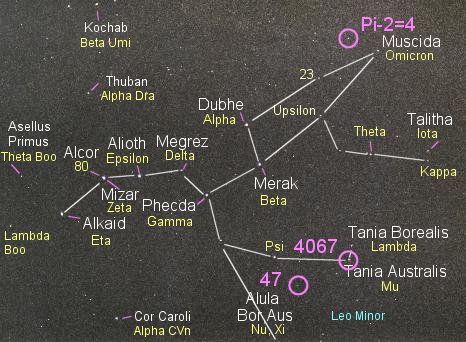 HR 4067 is host not only to a massive "Jupiter," but has a distant
class L companion that has such
a low mass that it is close to being a brown dwarf.
HR 4067 is host not only to a massive "Jupiter," but has a distant
class L companion that has such
a low mass that it is close to being a brown dwarf.
THE PLANET
The right-hand lower circle shows the location of the class F dwarf HR
4067 Ursae Majoris in the constellation Ursa
Major. The bright star in the circle is third magnitude Tania Australis (Mu UMa). Sixth magnitude
HR 4067 is tucked in just below and a bit to the right of it,
making the star incredibly easy to find. HR 4067 has a massive
planet that carries at least 7.99 times the mass of Jupiter. It
orbits the star with a period of 256.6 days at an average distance
of 0.89 Astronomical Units (134 million kilometers, 83 million
miles), 0.89 times the size of Earth's orbit around the Sun. The
orbit is highly eccentric, however, and takes the planet from as
far as 1.49 AU from its star to as close in as 0.29 AU, the latter
only 75 percent the distance of Mercury from the Sun.
|
 HR 4067 is host not only to a massive "Jupiter," but has a distant
class L companion that has such
a low mass that it is close to being a brown dwarf.
HR 4067 is host not only to a massive "Jupiter," but has a distant
class L companion that has such
a low mass that it is close to being a brown dwarf.
 HR 4067 is host not only to a massive "Jupiter," but has a distant
class L companion that has such
a low mass that it is close to being a brown dwarf.
HR 4067 is host not only to a massive "Jupiter," but has a distant
class L companion that has such
a low mass that it is close to being a brown dwarf.